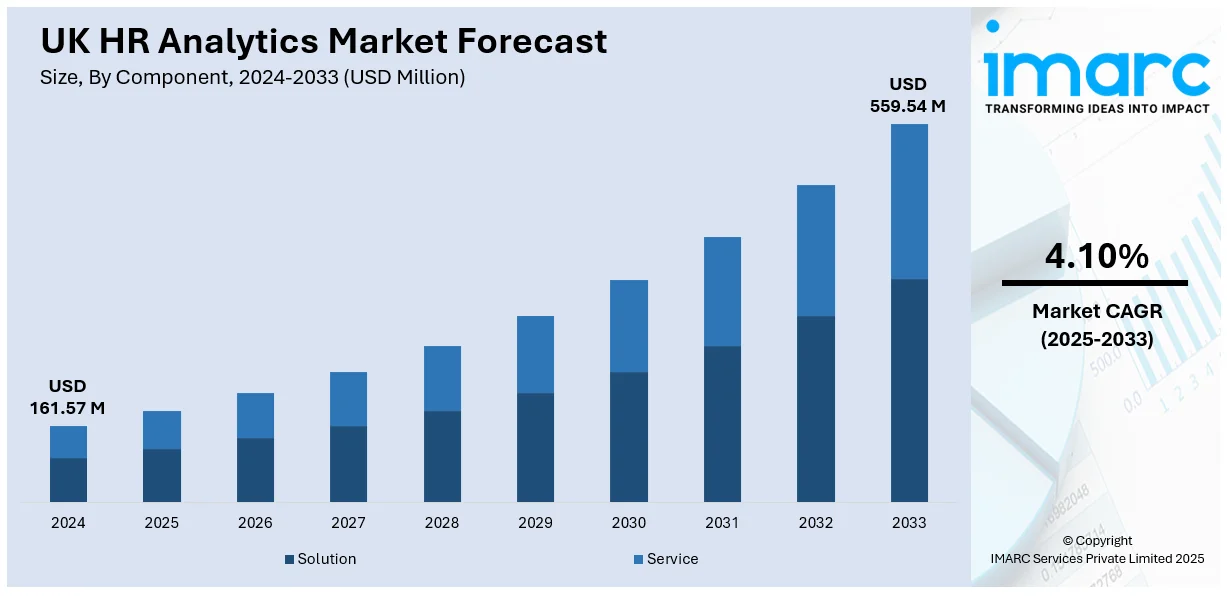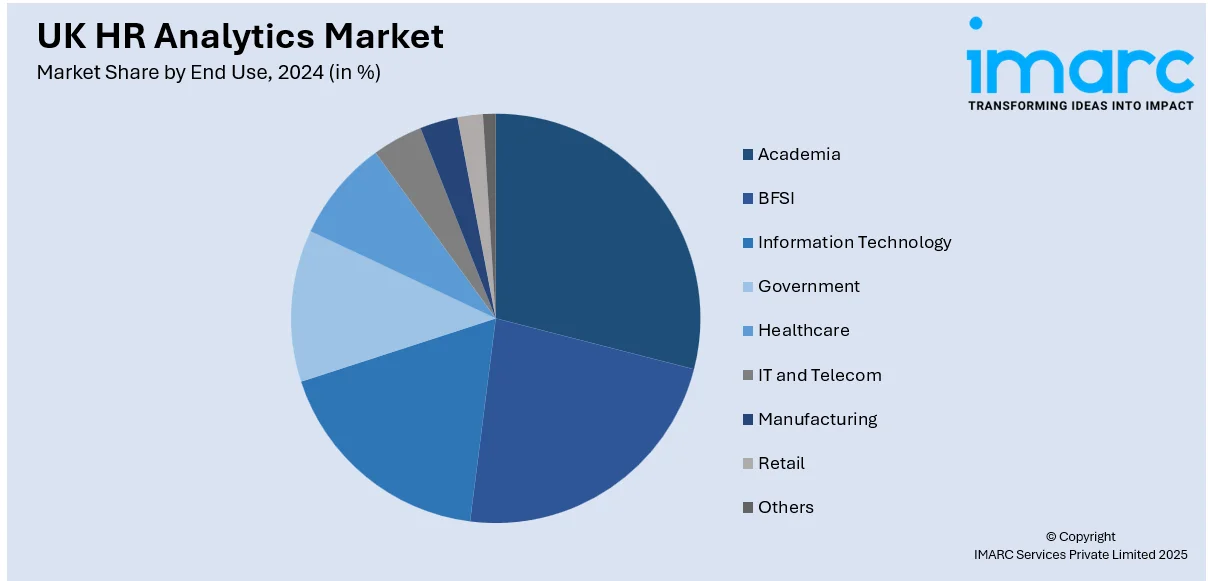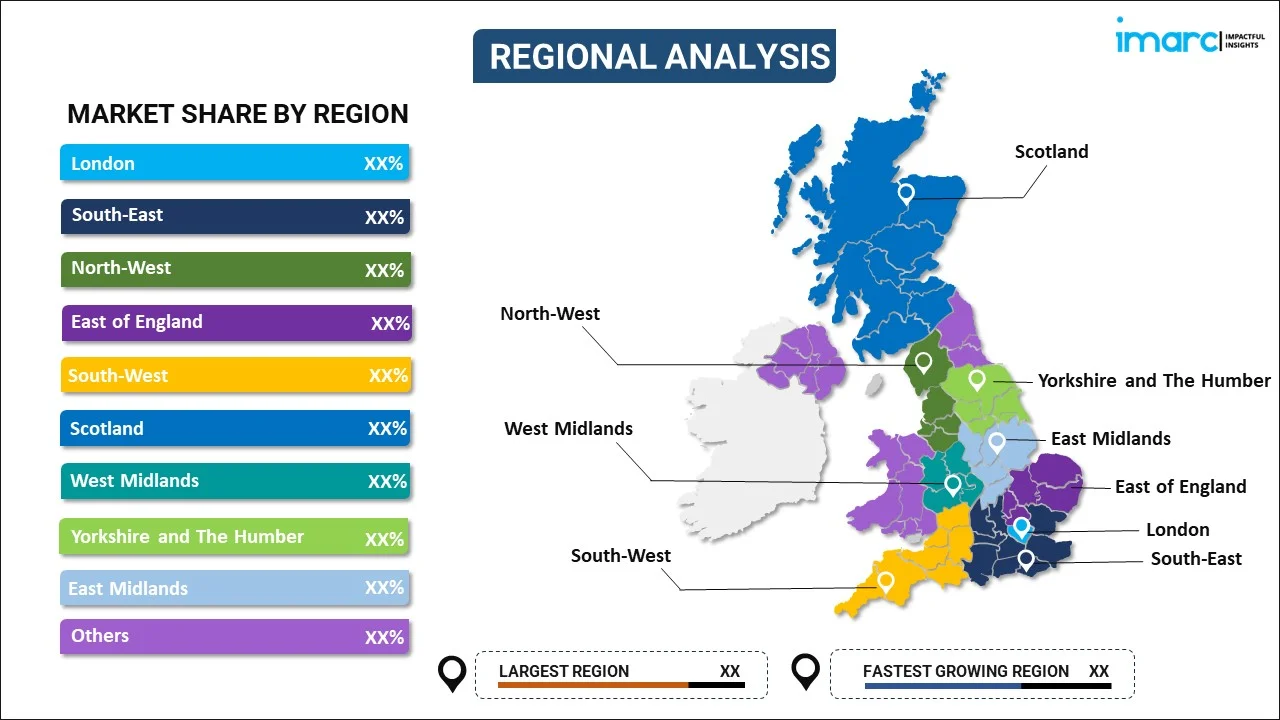
UK HR Analytics Market Size, Share, Trends and Forecast by Component, Deployment, Enterprise Size, End Use, and Region, 2025-2033
UK HR Analytics Market Size and Share:
The UK HR analytics market size was valued at USD 161.57 Million in 2024. Looking forward, IMARC Group estimates the market to reach USD 559.54 Million by 2033, exhibiting a CAGR of 14.10% from 2025-2033. The market is driven by the growing adoption of data-driven approaches that assist in enhancing workforce development, along with the increasing reliance on cloud-based HR analytics platforms that enable organizations for storing as well processing vast amounts of data.
|
Report Attribute
|
Key Statistics
|
|---|---|
|
Base Year
|
2024 |
|
Forecast Years
|
2025-2033
|
|
Historical Years
|
2019-2024
|
| Market Size in 2024 | USD 161.57 Million |
| Market Forecast in 2033 | USD 559.54 Million |
| Market Growth Rate (2025-2033) | 14.10% |
In the UK, the rising integration of human resource (HR) analytics with other business functions like finance, operations, and marketing is enabling companies to gain a more comprehensive view of their workforce, thereby positively influencing the market. This assimilation enables data sharing across departments and ascertains that HR insights are aligned with strategic goals and key performance indicators. Companies can better analyze the cost-effectiveness of their workforce in relation to revenue generation, identify areas where labor costs can be optimized, and align employee compensation with business objectives. Businesses can also optimize staffing levels based on operational needs and demand patterns to ensure that the suitable talent is recruited at the right time. Moreover, they can incorporate HR analytics into performance management systems (PMS) and employee engagement tools to align employee goals with organizational priorities and improve productivity.

The increasing focus on regulatory compliance, with businesses seeking efficient HR analytics tools to adhere to labor laws, tax regulations, and data protection rules, is impelling the market growth in the UK. HR analytics tools can automate and streamline key processes, such as employee data management (EDM), payroll, benefits, and reporting. With stringent regulations, HR departments need to ensure that personal and sensitive data is properly handled and that employees are treated fairly without bias. HR analytics systems make it easier to track and maintain accurate records, monitor compliance with equal pay laws, and ensure adherence to overtime and working hour regulations. HR analytics can detect discrepancies in pay equity or flag potential violations related to working conditions, which allow businesses to address compliance issues before they result in legal consequences.
UK HR Analytics Market Trends:
Rising digital transformation
The ongoing digital transformation is enabling organizations to modernize their HR functions and leverage technology to enhance decision-making, efficiency, and workforce management. Companies are adopting data-driven approaches by incorporating new technologies like artificial intelligence (AI), machine learning (ML), and automation into their human resources strategies. Advanced HR analytics tools allow organizations to gather, analyze, and interpret vast amounts of employee data as well as provide insights into various aspects of workforce management, including recruitment, employee performance, engagement, and retention. Moreover, robotic process automation (RPA) and AI-powered chatbots are being used to handle administrative tasks, such as scheduling interviews and answering employee queries. This automation allows HR professionals to focus on more strategic tasks, such as talent development and workforce planning, while also improving the speed and accuracy of HR processes. Furthermore, digital transformation enhances employee experience by enabling more personalized and flexible HR services. According to the IMARC Group’s report, the UK digital transformation market is projected to exhibit a growth rate (CAGR) of 19.20% during 2024-2032.
Growing concern about corporate wellness
As companies are recognizing the direct link between employee well-being and business performance, the demand for HR analytics is rising. Corporate wellness includes physical, mental, and emotional health. HR analytics provides actionable insights that help businesses to design and implement effective wellness programs. Organizations can track employee engagement, absenteeism, turnover, and overall health through HR analytics, which allows HR departments to identify patterns and potential issues. They also implement wellness strategies that are targeted and tailored as per employees’ actual needs. Furthermore, HR analytics aids in identifying factors contributing to employee burnout, stress, and low productivity, which are key aspects of corporate wellness. The data published on the website of the IMARC Group shows that the UK corporate wellness market is expected to reach USD 4.5 Billion by 2033.
Increasing utilization of cloud computing
The rising utilization of cloud computing is providing businesses with the flexibility, scalability, and cost-effectiveness required to manage and analyze vast amounts of HR data, thereby propelling the market growth. Cloud-based HR analytics platforms offer several advantages that support the rising demand for data-driven decision-making. They enable organizations to store and process data without the need for expensive on-premises infrastructure, which makes HR analytics tools more accessible to companies of all sizes. They allow HR professionals to access real-time data and insights from anywhere, at any time, and on any device. Leading cloud computing service providers implement stringent data protection measures, such as encryption and multi-factor authentication, to ensure that data remains secure. IMARC Group’s report predicted that the UK cloud computing market will exhibit a growth rate (CAGR) of 15.70% during 2024-2032.
UK HR Analytics Industry Segmentation:
IMARC Group provides an analysis of the key trends in each segment of the UK HR analytics market, along with forecasts at the regional and country levels from 2025-2033. The market has been categorized based on component, deployment, enterprise size, and end use.
Analysis by Component:
- Solution
- Employee Engagement and Development
- Payroll and Compensation
- Recruitment
- Retention
- Talent Analytics
- Workforce Planning
- Others
- Service
- Implementation and Integration
- Support and Maintenance
- Training and Consulting
The solution segment (employee engagement and development, payroll and compensation, recruitment, retention, talent analytics, workforce planning, and others) provides software platforms that enable organizations to monitor, assess, and enhance HR operations. These options assist companies in hiring, tracking employee performance, and utilizing predictive analytics for workforce strategy.
The services segment (implementation and integration, support and maintenance, and training and consulting) supports the adoption and implementation of HR analytics solutions. Service providers guarantee smooth implementation of analytics tools, customized according to particular business needs. Businesses, particularly those with restricted internal knowledge, depend on these services to enhance their HR strategies.
Analysis by Deployment:
- Hosted
- On-premises
Hosted deployment offers scalability, cost-efficiency, and flexibility. Businesses choose hosted solutions for easy implementation, regular updates, and reduced infrastructure costs. It supports remote access, which enables organizations to manage HR functions from anywhere. Moreover, it is beneficial to businesses of all sizes due to its subscription-based pricing and advanced data security measures.
Organizations favor on-premises deployment to achieve better control over data security and customization. Organizations that have a solid information technology (IT) foundation invest in on-site solutions to address particular HR requirements and guarantee adherence to industry standards. Long-term economic advantages can be gained by utilizing on-premises systems.
Analysis by Enterprise Size:
- Large Enterprise
- Small and Medium Enterprise
Due to the substantial workforce, large enterprises depend on HR analytics to improve recruitment, boost employee engagement, and refine workforce planning. Improved tools offer practical insights for making decisions and guarantee efficiency in operations. HR analytics aids large companies in reducing turnover and executing diversity programs.
Small and medium enterprises (SMEs) adopt HR analytics to enhance workforce efficiency and support business growth. They benefit from analytics tools that assist in simplifying recruitment and managing performance. Cost-effective strategies can be implemented in SMEs through HR analytics to foster a positive workplace culture.
Analysis by End Use:

- Academia
- BFSI
- Information Technology
- Government
- Healthcare
- IT and Telecom
- Manufacturing
- Retail
- Others
The academia segment employs HR analytics to boost recruitment, oversee faculty effectiveness, and increase employee engagement. Educational organizations utilize data-informed methods to assess employee contentment, enhance administrative workflows, and predict workforce requirements. Additionally, HR analytics aids diversity and inclusion efforts that establish a fair and balanced work environment.
The banking, financial services, and insurance (BFSI) sector depends on HR analytics for managing talent acquisition, employee engagement, and workforce planning. HR analytics enables companies to recognize skill deficiencies and enhance training initiatives. In addition, tools for HR analytics assist in guaranteeing compliance with labor laws and regulations.
The information technology (IT) industry utilizes cutting-edge resources to deal with labor issues in a rapidly evolving environment. HR analytics aids IT companies in attracting leading talent and tracking employee performance. IT firms focus on HR analytics to sustain a competitive advantage.
The healthcare sector employs HR analytics to manage workforce deficits, optimize scheduling, and boost employee satisfaction. Medical facilities and practices depend on information to track employee performance and minimize burnout. HR analytics also supports training initiatives to upskill the workforce and improve patient care.
The IT and telecom companies use analytics to improve hiring processes, monitor productivity, and implement performance-based incentives. HR analytics supports remote work management, diversity initiatives, and skill enhancement programs. IT and telecom firms employ HR analytics to supervise workforce challenges and adapt to industry needs.
In the manufacturing sector, workforce planning is streamlined through HR analytics. Companies use HR analytics tools to improve safety measures as well as to monitor employee performance and eradicate skill gaps via targeted training. HR analytics also reduce labor costs and ensure compliance with health and safety regulations.
The retail segment employs HR analytics to manage a dynamic workforce, improve hiring processes, and reduce turnover rates. Analytics tools enable retailers to monitor employee performance, align staffing with business needs, and implement training programs for skill development. HR analytics ensures that employees are engaged and productive to enhance user experience.
Regional Analysis:

- London
- South East
- North West
- East of England
- South West
- Scotland
- West Midlands
- Yorkshire and The Humber
- East Midlands
- Others
London has well-established multinational companies and innovative businesses, which leverage advanced HR analytics to optimize talent acquisition and employee engagement strategies. In the city, there is a competitive corporate environment that encourages the rapid adoption of advanced solutions like predictive analytics and AI.
The South East region is noted for its diverse industries like technology, finance, and manufacturing. Businesses adopt HR analytics to streamline recruitment, improve retention rates, and enhance employee productivity. In the region, companies are investing in analytics tools to support innovation and workforce development.
In the North West region, companies use analytics to optimize workforce management, reduce attrition, and enhance employee well-being. HR analytics are utilized to deliver actionable insights regarding performance and engagement. Organizations employ these tools to improve decision-making processes and support long-term workforce strategies.
The burgeoning IT and research and development (R&D) sectors are making the East of England a prominent hub for HR analytics. Local businesses rely on analytics to enhance talent acquisition, monitor employee satisfaction, and forecast workforce trends. The region felicitates an innovative environment that encourages companies to adopt cutting-edge solutions to improve efficiency and retain top talent.
The South West enjoys flourishing tourism, healthcare, and farming sectors. Organizations utilize analytics to enhance scheduling, monitor employee performance, and lower operational expenses. Additionally, the area focuses on workforce health and productivity, which promotes investment in data-oriented solutions.
Scotland has well-developed financial services, energy, and public sectors. In the region, analytics are employed to address workforce challenges like skill shortages and employee retention. The region focuses on innovation and sustainable practices, which promote the adoption of HR analytics.
The thriving automotive, manufacturing, and service industries are making the West Midlands the key region for HR analytics adoption. Analytics enables businesses to refine workforce planning, save on costs, and elevate training programs. HR analytics facilitates the development of organizations and boosts employee satisfaction levels across the region.
In the Yorkshire and the Humber region, the thriving healthcare, logistics, and education industries utilize HR analytics tools to optimize operations. Regional companies adopt analytics to optimize recruitment and monitor employee performance. The region emphasizes workforce development that requires innovative HR tools.
The East Midlands region benefits from its well-setup manufacturing, retail, and logistics industries. Businesses use analytics to improve talent management, forecast labor needs, and enhance workplace culture. The region focuses on productivity and efficiency to ensure high adoption of HR analytics.
Competitive Landscape:
Key players are developing advanced solutions that help businesses make data-driven decisions. They are offering a variety of software platforms that streamline HR functions, such as recruitment, employee performance management, and workforce planning. They are also investing in R&D activities to increase the capabilities of their analytics tools by incorporating AI, ML, and predictive analytics. In addition, they are emphasizing customer-centric approaches by offering training programs and supporting services and workshops for enabling organizations to maximize the benefits of HR analytics. Moreover, they are addressing regulatory compliance by incorporating features that align with data privacy laws to build trust among clients. They are also collaborating with HR service providers and corporate clients to expand their reach and influence. For instance, in June 2024, the CIPD, a prominent professional body for HR and people development, introduced Ciphr, the leading HR solution provider, as its latest people development partner (PDP). The announcement aims to offer modern HR solutions for UK-based organizations and enable users to manage tasks across HR, payroll, and recruitment.
The report provides a comprehensive analysis of the competitive landscape in the UK HR analytics market with detailed profiles of all major companies.
Latest News and Developments:
- November 2024: SAP SE, the leading enterprise applications and business AI company, unveiled the unity cluster program, which aims to deliver shared services for HM Revenue and Customs (HMRC), the Department for Transport (DfT), and the Ministry for Housing, Communities and Local Government (MHCLG) in the UK. This collaboration aims to deliver a modern, efficient, and secure digital platform for HR, finance, and procurement services.
UK HR Analytics Market Report Scope:
| Report Features | Details |
|---|---|
| Base Year of the Analysis | 2024 |
| Historical Period | 2019-2024 |
| Forecast Period | 2025-2033 |
| Units | Million USD |
| Scope of the Report | Exploration of Historical Trends and Market Outlook, Industry Catalysts and Challenges, Segment-Wise Historical and Future Market Assessment:
|
| Components Covered |
|
| Deployments Covered | Hosted, On-premises |
| Enterprise Sizes Covered | Large Enterprise, Small and Medium Enterprise |
| End Uses Covered | Academia, BFSI, Information Technology, Government, Healthcare, IT and Telecom, Manufacturing, Retail, Others |
| Regions Covered | London, South East, North West, East of England, South West, Scotland, West Midlands, Yorkshire and The Humber, East Midlands, Others |
| Customization Scope | 10% Free Customization |
| Post-Sale Analyst Support | 10-12 Weeks |
| Delivery Format | PDF and Excel through Email (We can also provide the editable version of the report in PPT/Word format on special request) |
Key Benefits for Stakeholders:
- IMARC’s report offers a comprehensive quantitative analysis of various market segments, historical and current market trends, market forecasts, and dynamics of the UK HR analytics market from 2019-2033.
- The research study provides the latest information on the market drivers, challenges, and opportunities in the UK HR analytics market.
- Porter's Five Forces analysis assists stakeholders in assessing the impact of new entrants, competitive rivalry, supplier power, buyer power, and the threat of substitution. It helps stakeholders to analyze the level of competition within the UK HR analytics industry and its attractiveness.
- Competitive landscape allows stakeholders to understand their competitive environment and provides an insight into the current positions of key players in the market.
Key Questions Answered in This Report
HR analytics involves using data-driven techniques to analyze workforce metrics and optimize HR strategies. It helps organizations make informed decisions about employee engagement, performance management, and workforce planning. It also assists in improving hiring processes, forecasting workforce needs, managing diversity initiatives, and aligning HR goals with business objectives.
The UK HR analytics market was valued at USD 161.57 Million in 2024.
IMARC estimates the UK HR analytics market to exhibit a CAGR of 14.10% during 2025-2033.
The rising usage of HR analytics to assist businesses in identifying diversity gaps and assessing bias in recruitment and promotion processes, is positively influencing the market. Moreover, HR analytics are enabling organizations to reduce operational costs related to turnover and inefficiencies, which is fueling the market growth. The increasing investments in advanced HR technologies to make analytics tools more efficient are further bolstering the market growth across the region.
Need more help?
- Speak to our experienced analysts for insights on the current market scenarios.
- Include additional segments and countries to customize the report as per your requirement.
- Gain an unparalleled competitive advantage in your domain by understanding how to utilize the report and positively impacting your operations and revenue.
- For further assistance, please connect with our analysts.
 Inquire Before Buying
Inquire Before Buying
 Speak to an Analyst
Speak to an Analyst
 Request Brochure
Request Brochure
 Request Customization
Request Customization




.webp)




.webp)












